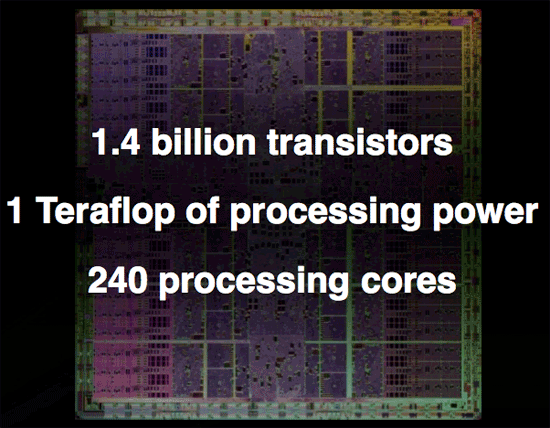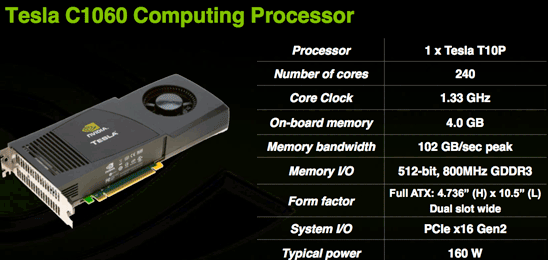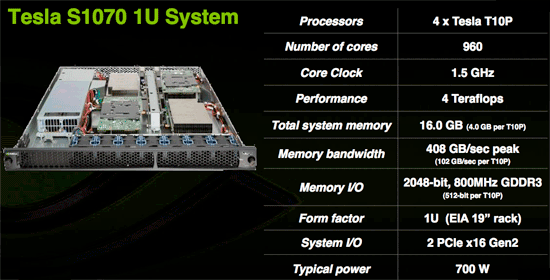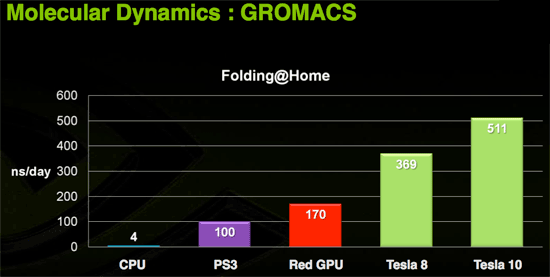NVIDIA's 1.4 Billion Transistor GPU: GT200 Arrives as the GeForce GTX 280 & 260
by Anand Lal Shimpi & Derek Wilson on June 16, 2008 9:00 AM EST- Posted in
- GPUs
Overclocked and 4GB of GDDR3 per Card: Tesla 10P
Now let's say that you want to get some real work done with NVIDIA's GT200 GPU but that 1.4 billion transistor chip just isn't enough. NVIDIA does have an answer for you, in the form of an overclocked GT200 with the 240 SPs running at 1.5GHz (up from 1.3GHz in the GTX 280) and with a full 4GB of GDDR3 memory on-board.

Today NVIDIA is also announcing their next generation Tesla product based on GT200 (called a T10P when used on Tesla for some reason). The workstation graphics guys will have to wait a while for a GT200 Quadro unfortunately. This new Tesla is similar to the older model in that it has much more RAM and no IO ports. The server version is also clocked higher than the desktop part because fan noise isn't an issue and data centers have lower ambient temperatures than some corner of an office under a desk.

The Tesla C1060 has an entire 4GB of RAM on board. This is obviously very large and will do well to accomodate the large scale scientific computing apps it is targeted at. This card is designed for use in workstations and is the little brother to the new monster server that is also being announced today.

The Tesla S1070 is a 1U server containing essentially 4 C1060 cards for a total of 16GBs of RAM on 960 SPs. This server, like the older version, connects to a server via a PCIe cable and is designed to run code written for CUDA at incredible speeds. With 120 double precision IEEE 754r floating point units in combination with the 960 single precision IEEE 754 units, this server is a viable option for many more projects than the previous Tesla hardware which was only capable of single precision floating point.
Though we don't have an application to benchmark the double precision floating point hardware on GT200 yet, NVIDIA states that a GT200 can roughly match an 8 core Xeon system in DP performance. This would put the S1070 on par with a 32 way Xeon setup at less than 700W. Needless to say, single precision code runs much much faster and can outpace hundreds of traditional CPUs in parallel.
While these servers are expensive (though we don't have pricing), they are cheap compared to the alternatives currently out there. The fact that CUDA code can be implemented and tested on any of the 70 million NVIDIA G80+ GPUs currently in people's hands means that developer already have a platform to test and debug code on before committing to the Tesla solution. On top of that, schools are beginning to adopt CUDA as a teaching tool for parallel computing. As CUDA gains acceptance and the benefits of GPU computing are realized, more and more major markets will take interest.
The graphics card is no longer a toy. The combination of CUDA's academic acceptance as a teaching tool and the availability of 64-bit floating point in GT200 make GPUs a mission critical computing tool that will act as a truly disruptive technology. Not only will many major markets that depend on high performance floating-point processing realize this, but every consumer with an NVIDIA graphics card will be able to take advantage of hundreds of gigaflops of performance from CUDA based consumer applications.

Today we have folding@home and soon we'll have Elemental's transcoder. Imagine the audio and video processing capabilities of a PC if the GPU were actively used in software like ProTools and Premier. Open source programs could easily best the processing capabilities of many solutions with dedicated hardware for these types of applications.
Of course, the major limiter to the adoption of this technology is that it is vendor specific. If NVIDIA put the time in (or enlisted help) to make CUDA an ANSI or ISO standard extention to a programming language, we would could really start to get excited. Beyond that, the holy grail would be a unification of virtualized instruction sets creating a standard low level "assembly" interface for GPU computing allowing CUDA to compile to one target and run on any graphics card. Sort of an x86 for massively parallel work.
Right now CUDA compiles to PTX, NVIDIA's virtual instruction set, and there is no reason someone couldn't write a CUDA compiler to target AMD's equivalent CAL (or even to develop a PTX to CAL wrapper that allowed AMD GPUs to run compiled CUDA code). Unfortunately, NVIDIA doesn't want to invest money and resources in extending functionality to AMD and AMD doesn't want to invest money and resources into bolstering an NVIDIA owned technology (that could theoretically radically change to cripple AMD's hardware support in future versions). While standards and cooperation are a great idea, the competition in this market is such that neither NVIDIA nor AMD are looking to take a chance on benefiting the consumer if there is any risk of strenthening the competition (even in spite of weakening the industry).










108 Comments
View All Comments
tkrushing - Wednesday, June 18, 2008 - link
Say what you want about this guy but this is partially true which is why AMD/ATI is in the position they have been. They are slowly climbing out of that hole they've been in though. Would have been nice to see 4870x2 hit the market first. As we know competition = less prices for everyone!hk690 - Tuesday, June 17, 2008 - link
I would love to kick you hard in the face, breaking it. Then I'd cut your stomach open with a chainsaw, exposing your intestines. Then I'd cut your windpipe in two with a boxcutter. Then I'd tie you to the back of a pickup truck, and drag you, until your useless fucking corpse was torn to a million fucking useless, bloody, and gory pieces.
Hopefully you'll get what's coming to you. Fucking bitch
http://www.youtube.com/watch?v=XNAFUpDTy3M">http://www.youtube.com/watch?v=XNAFUpDTy3M
I wish you a truly painful, bloody, gory and agonizing death, cunt
7Enigma - Wednesday, June 18, 2008 - link
Anand, I'm all for free speech and such, but this guy is going a bit far. I read these articles at work frequently and once the dreaded C-word is used I'm paranoid I'm being watched.Mr Roboto - Thursday, June 19, 2008 - link
I thought those comments would be deleted already. I'm sure no one cares if they are. I don't know what that person is so mad about .hk690 - Tuesday, June 17, 2008 - link
Die painfully okay? Prefearbly by getting crushed to death in a garbage compactor, by getting your face cut to ribbons with a pocketknife, your head cracked open with a baseball bat, your stomach sliced open and your entrails spilled out, and your eyeballs ripped out of their sockets. Fucking bitch
Mr Roboto - Wednesday, June 18, 2008 - link
Ouch.. Looks like you hit a nerve with AMD\ATI's marketing team!bobsmith1492 - Monday, June 16, 2008 - link
The main benefit from the 280 is the reduced power at idle! If I read the graph right, at idle the 9800 takes ~150W more than the 280 while at idle. Since that's where computers spend the majority of their time, depending on how much you game, that can be a significant cost.kilkennycat - Monday, June 16, 2008 - link
Maybe you should look at the GT200 series from the point of view of nvidia's GPGPU customers - the academic researchers, technology companies requiring fast number-cruching available on the desktop, the professionals in graphics-effects and computer animation - not necessarily real-time, but as quick as possible... The CUDA-using crew. The Tesla initative. This is an explosively-expanding and highly profitable business for nVidia - far more profitable per unit than any home desktop graphics application. An in-depth analysis by Anandtech of what the GT200 architecture brings to these markets over and above the current G8xx/G9xx architecture would be highly appreciated. I have a very strong suspicion that sales of the GT2xx series to the (ultra-rich) home user who has to have the latest and greatest graphics card is just another way of paying the development bills and not the true focus for this particular architecture or product line.nVidia is strongly rumored to be working on the true 2nd-gen Dx10.x product family, to be introduced early next year. Considering the size of the GTX280 silicon, I would expect them to transition the 65nm GTX280 GPU to either TSMC's 45nm or 55nm process before the end of 2008 to prove out the process with this size of device, then in 2009 introduce their true 2nd-gen GPU/GPGPU family on this latter process. A variant on the Intel "tic-toc" process strategy.
strikeback03 - Tuesday, June 17, 2008 - link
But look at the primary audience of this site. Whatever nvidia's intentions are for the GT280, I'm guessing more people here are interested in gaming than in subsidizing research.Wirmish - Tuesday, June 17, 2008 - link
"...requiring fast number-cruching available on the desktop..."GTX 260 = 715 GFLOPS
GTX 280 = 933 GFLOPS
HD 4850 = 1000 GFLOPS
HD 4870 = 1200 GFLOPS
4870 X2 = 2400 GFLOPS
Take a look here: http://tinyurl.com/5jwym5">http://tinyurl.com/5jwym5